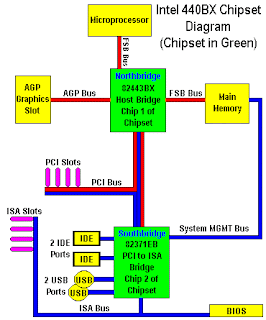- Get link
- X
- Other Apps
- Get link
- X
- Other Apps
PCI/AGP/ISA/IDE Controlers

Why is it called a chipset? Because in the past there were always two or more of these on a motherboard. Some motherboards now have only one chip that performs all of the duties of the chipset, but others still use two or more chips. Chipsets are like the motherboard's traffic cops. They direct the flow of data from one point to another. Each chip in the chipset has its own particular job. This is the 440BX chipset. One chip links directly to the microprocessor. Above is a picture of the 440BX chipset. Below is the "Intel 82443BX PCI/AGP Controller." It is hidden under a heat sink that protects it from overheating.

The 82443BX Northbridge chip controls the data traffic between the microprocessor and the rest of the motherboard. It also controls the traffic to and from the AGP card. Both chips share in the task of controlling the PCI and main memory data flow. In the diagram below you can see the data flow paths mapped out for the chipset. The paths managed by chip 1, (or the Northbridge chip), are shown in red. The paths managed by chip 2, (or the Southbridge chip), are shown in blue. The duties of the chips may vary slightly depending on the chipset. For some chipsets, the Northbridge may control the CPU, video, and main memory traffic, while the "Southbridge" chip may control the other traffic


The paths between each component are referred to as "buses." Buses are simply the paths, or wires, that connect one component to another. The chips in the chipset are referred to as bridges, because they bridge the components together and ensure that the data flow is directed to the proper place. The better chipsets are those that can handle data the fastest and most efficiently. Below is a picture of both of the chipsets on the motherboard
Comments